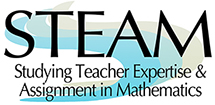

To measure instructional practice, we adapted a protocol that is aligned with research and widely accepted recommendations for mathematics instruction (National Council of Teacher of Mathematics, 2000; 2014) and that had demonstrated significant predictive power in earlier large-scale studies of student outcomes (Authors, 2013). The protocol consists of eight elements, classified into three themes: Reasoning about Mathematics (R), Students' Thinking in Instruction (ST), and Focus on Sense-Making (SM). For each element, observers applied a detailed rubric to render ratings from 1 to 5, with 1 largely indicating an absence of the characteristics and 5 indicating a strong presence of the characteristic; thus, scores range from 8 to 40 for each observation. Each teacher in the study was observed for three separate lessons throughout the school year.
To measure differences in teachers' pedagogical content knowledge, we used the Learning Mathematics for Teaching instrument (Schilling, Blunk, & Hill, 2007). The LMT consists of sets of 20 multiple-choice items, each in a different domain, and measures knowledge that is related to teaching mathematics. That is, items assess not only participants' understanding of mathematical concepts, but also their ability to evaluate unusual solution methods, represent ideas for students, and identify adequate mathematical explanations. In our project, each participant took four LMT subtests (Elementary School Number Concepts and Operations; Elementary School Patterns, Functions and Algebra; Grades 4-8 Geometry; and Grades 4-8 Probability, Data and Statistics) at the beginning of the study. The test was administered online, with instructions to avoid consulting outside resources.
To measure teacher beliefs and other background characteristics, we used portions of the Horizon 2012 National Survey of Science and Mathematics Education (Mathematics Teacher Questionnaire), portions of the 2015 NAEP Grade 4 Mathematics Questionnaire, a beliefs survey developed by White and colleagues (2005), and other items that were constructed by our research team. In Year 1, the survey was deployed in the summer prior to any teaching observations. In Years 2 and 3, the survey was deployed in parts at three time points: one part in the summer prior to observations, one part in December, and one part in May at the end of the school year.
To measure student achievement, we used the state mathematics assessment results for each student in participating teachers' classrooms. School personnel submitted prior year assessment results for use as baseline data, as well as assessment results at the end of each year of participation in the study.